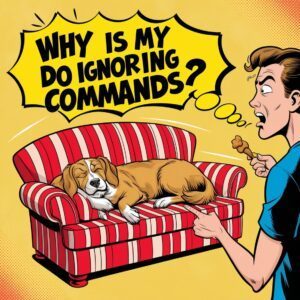Get your free Book Here

Decoding Dog Behavior: What Your Pup’s Actions Really Mean
If you’re a dog lover like me, you know that our furry companions have a language of their own. Every wag of their tail, bark, and playful leap says something. Understanding this doggy dialect can transform the bond you share with your four-legged friend from simply being companions to becoming partners in an incredible journey together. So, grab a cozy spot and let’s decode the fascinating world of dog behavior!
1. The Art of the Wagging Tail
Ah, the tail – one of the most expressive parts of a dog’s anatomy! It’s often said that dogs communicate with their tails, and it’s true! But what does that wagging actually mean?
-
Fast and Furiously Wagging: A wagging tail can indicate excitement and happiness. It’s your pup’s way of saying, "I’m happy to see you!" or "This is thrilling!"
-
Slow Wagging: If your dog wags their tail slowly, it may mean they’re unsure or cautious. This is their way of being polite while assessing the situation.
-
Tucked Tail: A tail tucked firmly between the legs often indicates fear or submission. This is your pup’s way of saying, “I mean no harm!”
Tail communication is rich and layered. Different breeds may express their emotions in varying ways, so it’s vital to pay attention not just to the tail but to the entire body language of your pup.
2. The Many Faces of Barking
Every dog has their own unique bark, and believe it or not, each bark can mean something different. Barking is a dog’s primary means of communication, and understanding the nuances can help enhance your relationship.
-
Short Barks: A series of short barks often indicates excitement or a need to get your attention. Your dog might want to play or retrieve that ball you threw!
-
Deep, Slow Barks: Your pup might be feeling protective, signaling that someone is approaching their territory.
-
High-Pitched Barking: This could indicate excitement or anxiety. It’s a way for your pup to express heightened emotions, whether positive or negative.
Listening to your dog’s barking style can offer insight into their feelings, helping you respond more appropriately to their needs.
3. The Power of Eye Contact
Did you know that eye contact is another crucial aspect of dog communication? Dogs use their eyes not just to see but to communicate their feelings and intentions.
-
Soft, Relaxed Eyes: When your dog’s eyes are relaxed and their body is comfortable, it’s a sign they are at ease.
-
Fixed Stare: A direct, intense stare might indicate a challenge or discomfort. It’s essential to monitor your dog’s body language for signs of stress.
-
Squinty Eyes: We often see dogs squinting when they’re feeling playful or relaxed. It indicates trust and comfort in their environment.
Creating a healthy bond includes recognizing and respecting your dog’s comfort level with eye contact. For some dogs, too much staring can lead to anxiety, while for others, it’s a soothing sign of trust.
4. The Importance of Body Language
Just like human emotions, dogs express themselves through various body language signals. Tuning into these signals can improve your understanding of your furry friend.
-
Play Bow: This signals that your dog is ready to play. They’ll lower their front legs while keeping their back legs upright—a classic invitation!
-
Rolling Over: If your pup rolls over and shows you their belly, it’s more than just a sign of submission; it’s a request for attention and affection.
-
Stiff Body: A dog that suddenly becomes rigid might feel threatened. It’s beneficial to remove them from the situation to avoid potential conflicts.
Recognizing your dog’s body language helps establish a trusting relationship, ensuring that both you and your pup feel comfortable in your interactions.
5. The Significance of Chewing and Nipping
If your dog has taken a sudden interest in chewing on your favorite shoes or nipping at your hands, don’t fret! Chewing and nipping are normal dog behaviors that can signify various needs or emotions.
-
Nipping During Play: Puppies often nip each other during playtime. It’s their way of interacting but can become a problem if it transitions to adults.
-
Chewing to Relieve Stress: If your dog is fighting separation anxiety or boredom, chewing can provide comfort. Chewing releases feel-good hormones and can help soothe them.
-
Exploration: For puppies, chewing is a means of exploring their environment—much like a baby would use their mouth to discover the world.
If chewing becomes destructive, provide your dog with appropriate toys and engage them in regular exercise to alleviate their need to chew on unsuitable items.
6. Understanding Fear and Anxiety
It’s heartbreaking to see our pups anxious or afraid. Often, they express their feelings through behavior and actions that can help us identify their emotions.
-
Hiding: Dogs may choose to hide in their favorite spot when they feel anxious. This is a natural instinct, as they seek comfort and safety.
-
Excessive Barking or Whining: This can often indicate anxiety. Pay attention to triggers that cause your pup distress and try to minimize exposure.
-
Pacing or Restlessness: If your dog is unable to settle down, it may be feeling overwhelmed. A calming environment can help soothe anxious pups.
Understanding your dog’s anxiety triggers opens the door to providing them with the support they need. Creating a safe space and utilizing training techniques can significantly help alleviate their fears.
7. Love and Affection – How Dogs Show They Care
Dogs are incredibly loving creatures, and they have unique ways of expressing their affection. Here are some heartwarming behaviors you might notice:
-
Sitting Close: When your pup snuggles up next to you, they’re demonstrating their affection and desire for closeness.
-
Bringing You Toys: If your dog brings you their favorite toy, it’s a gesture of love! They want to share their joy with you.
-
Licking: Dogs often lick their owners as a sign of affection. However, excessive licking can lead to irritation or anxiety, so balance is essential.
Recognizing these sweet gestures strengthens your bond and ensures that your pup feels loved and appreciated.
8. Training the Bond – Communication Leads to Understanding
Ultimately, the bond between you and your dog can be enhanced by consistent communication. Training isn’t just about teaching commands; it’s about developing a communication system that fosters understanding.
-
Positive Reinforcement: This is one of the best training methods. Rewarding your dog for good behavior encourages them to repeat those actions.
-
Consistent Commands: Using the same commands consistently helps your dog understand what you expect from them.
-
Mutual Learning: You learn to understand your dog’s signals, and in return, your dog learns to interpret your actions and commands.
Investing time in training and communication creates a harmonious environment where both you and your pup can thrive.
Conclusion
Decoding dog behavior is a beautiful journey filled with love, laughter, and countless adorable moments. Each wag, bark, and gaze tells a story, reminding us that our pups communicate their thoughts and feelings in ways we can learn to understand. The more we decode their behavior, the stronger the bond we’ll share. After all, every loving dog deserves a keen observer to appreciate their unique expressions.
So next time your pup wags their tail or brings you their favorite toy, take a moment to appreciate the message they’re sending. With a little patience and understanding, we can all become fluent in the language of love that our furry friends speak.
FAQs
1. How can I tell if my dog is happy?
Look for signs like wagging tails, relaxed body language, and a playful demeanor. Happy dogs often seek your company and initiate play.
2. What does it mean when my dog yawns?
Yawning can indicate fatigue, but it can also be a sign of stress or discomfort. Pay attention to the context in which it occurs.
3. Why does my dog circle before lying down?
This is an instinctive behavior rooted in their ancestry—dogs would circle to create a comfortable or safe space before resting.
4. What should I do if my dog is fearful or anxious?
Identify the triggers causing anxiety and provide a safe space for your dog. Gradual desensitization to fears can also help. Consulting a vet or trainer can be beneficial.
5. How important is training for my dog?
Training is crucial for establishing communication and trust, ensuring that your dog understands your expectations and feels secure in their environment.
Unlock the Secrets to a Well-Behaved Dog! 🐾 Tired of your pup’s bad habits? Discover how to transform your unruly dog into a loving companion with our FREE Dog Training Mini Course! Learn essential commands, potty training tips, and effective techniques to eliminate unwanted behaviors in just days. Don’t miss out—sign up now and start your journey to a happier, obedient dog! Join Here! (https://bit.ly/3RJak0a)
Instantly Access Your Free Children’s Books Here! (https://payhip.com/BlueCherryStore) –
Disclaimer: As an Amazon Associate, I earn from qualifying purchases, I may earn a commission from qualifying purchases as an affiliate. Please note that I only recommend products I believe will provide value to my readers. (M)







